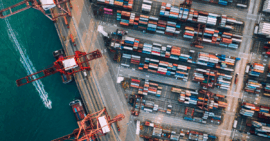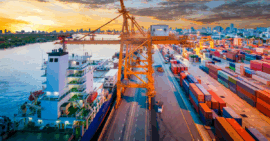As business, legal and tax leaders around the globe adjust to what experts are calling ‘the new normal’, regulatory compliance continues to influence the management of supply chains.
In fact, according to the Thomson Reuters’ Cost of Compliance Report, 34% of firms in 2020 are planning to outsource some (or all) of its compliance functionality, as the need for compliance assurance continues to grow.
During a Return to Better virtual conference presentation, Clay Perry, President at 143 Advisory Services LLC moderated a session around how supply chain management has taken a technological turn and the key trends that have emerged. He was joined by three other esteemed thought leaders who each shared their insights and ideas. They included:
- Michael Milnes, Senior Manager Practical Law, Competition and Consumer Protection at Thomson Reuters and Principal Lawyer at Supplied Legal
- Zoe Martinez, Proposition Lead, Global Trade at Thomson Reuters and
- Sally Gao, Data Scientist at Thomson Reuters.
Thanks to the unique perspectives aired during the ‘Supply Chain Trends and Business Operations’ virtual conference session, we’ve developed this article to help you refresh your approach to supply chain management.
Supply chain management trends
With over 20 years of experience in the global trade industry, Clay Perry understands the importance of keeping up with the latest trade compliance developments.
“It’s a very dynamic world that we live in and is constantly changing. We’ve got to keep our supply chains safe, secure and resilient.”
– Clay Perry, President at 143 Advisory Services LLC
Clay said that while we live “in a world of global supply chains”, organisations must be prepared to deal with any risks that impact the marketplace.
According to Michael Milnes, one major trend is that COVID-19 has caused a massive shift in patterns of supply and demand between different industries. Many organisations have been forced to shut down, whereas others are working around the clock to keep up with unprecedented demand.
“You’ve got entire industries either closing down but others are going into overdrive, like the pharmaceutical sector or grocery sector. Then industries, like aviation, tourism, university and education had to shut overnight,” he explained.
Another insight Michael mentioned was the fact that some organisations, for example, in the aviation and supermarket sectors, are now working with their competitors to maintain supplies for the community, which previously would have triggered a competition law concern.
“I think that the same way that we’ve had the waves of the coronavirus, the first wave and second wave, there’s also waves of response,” he said.
“There’s a moment where people realise that we’re all in this together and how can we make it work, as it’s in everybody’s interests for suppliers to survive.”
Part of that survival can be demonstrated by organisations who adapt with innovative technologies. Automated functions are becoming more accessible to implement, such as robotics in supply chain operations and in warehouses, added Michael.
“There’s a new urgency to it, with people becoming more used to working with automated systems and taking humans out of the loop from day-to-day-operations, people are more comfortable with that.”
– Michael Milnes, Senior Manager Practical Law, Competition and Consumer Protection at Thomson Reuters and Principal Lawyer at Supplied Legal
“And businesses realising that those that have the automated systems have been better able to respond.”
Finally, Michael shared his prediction on how organisations and suppliers will continue to work together.
“Perhaps we’ll move forward into a world with more use of relationship-based contracts, where we choose our suppliers as partners and not push all the risk on to them all the time,” he said.
The automation solutions space
Zoe Martinez has observed that supply chain resilience has been a challenge within the last 12 to 18 months, starting with trade tensions between the United States and China. And as goals among organisations shift from growth to survival, taking advantage of what technology has to offer is essential.
“I think the reality that major corporates of the world are really facing is that we’re not talking about returning to what it was like before COVID, or before we had the trade war, we’re really talking about a new normal,” she said.
She explained that organisations need to seriously consider these solutions, as it can help compliance and business professionals stay acutely aware of regulatory developments. For instance, businesses ought to be asking themselves the following questions:
- What are my risks right now?
- How can I quickly assess these risks?
- Can I do business with this new supplier?
- Can I work with this country (are there sanctions)?
- If I do bring in a product from this new supplier, what’s the impact on my duties?
“I think there’s going to be a lot more in terms of automation between partners, that type of connectivity that can help you shift on some of your manual processes towards further integration.”
– Zoe Martinez, Proposition Lead, Global Trade at Thomson Reuters
“And we’ve seen this play out between major corporations and their brokers or freight forwarders, but we’re also seeing those changes at an economic level,” she added.
To wrap up, Zoe reminded that while organisations will need to invest in these automation solutions to see results, she hinted that providers of these services also need to do their bit to deliver.
“The obligation is really on providers to make sure that solutions that are out there really deliver on compliance and accurate content,” she concluded.
Machine learning to reduce risk
From artificial intelligence to robotics, organisations around the globe are known for thriving on innovative technologies. Through a project at Thomson Reuters, Sally Gao developed a model that would help our Global Trade customers classify products according to the Harmonised Tariff Schedule (HTS), a nomenclature that governs import tariffs in the U.S using 10-digit codes.
“My project was done in partnership with Integration Point and the global trade business at Thomson Reuters. The goal was to classify US tariff schedule codes based on customer product descriptions,” she explained.
Sally detailed that her project focused on the apparel industry. The purpose was to create a model that classified items into HTS codes based on their product description. The benefit of the model is that it reduces the risk of human error, preventing large-scale financial and administrative consequences.
“It can be very time consuming for a human to determine the correct code. And from a compliance risk angle, submitting the wrong code can lead to some hefty penalties from tax authorities.”
– Sally Gao, Data Scientist at Thomson Reuters
She went on to explain that the HTS model was able to learn and then emulate customer patterns via machine learning.
“On average, we found that it was accurate 93% of the time for its top prediction, but if you asked it to give its top five predictions, it was accurate 99% of the time,” Sally noted.
Interestingly, as Sally highlighted, the model began to recognise patterns in the data without being explicitly told about them, which made the project even more interesting.
“It really showcases what data science has to offer, as opposed to more traditional non-data based software approaches, which generally require lots of hand-tailored algorithms and hard-coded logic,” Sally said.
But of course, technology like this can’t be used on every project. It is Sally’s view that the opportunities that can assist customers and are “ripe for automation” are of most value.
“What makes Thomson Reuters special is that it has access to huge amounts of data. It has a news business and access to customers
“What we’re able to do at the Labs is put together all these different data sources together and pair them with the latest developments in the field of AI.”
Adapting to the new normal: Road ahead
As COVID-19 continues to challenge the global supply chain, the stakes remain high for organisations to remain focused.
Automation and artificial intelligence will continue to be at the heart of operations management for many businesses.
“We’re moving towards a new normal, but the one thing that won’t change is change. Governments will continue to change laws to change regulations, and we must ensure we stay resilient through the use of automation and technology and artificial intelligence,” concluded Clay.


